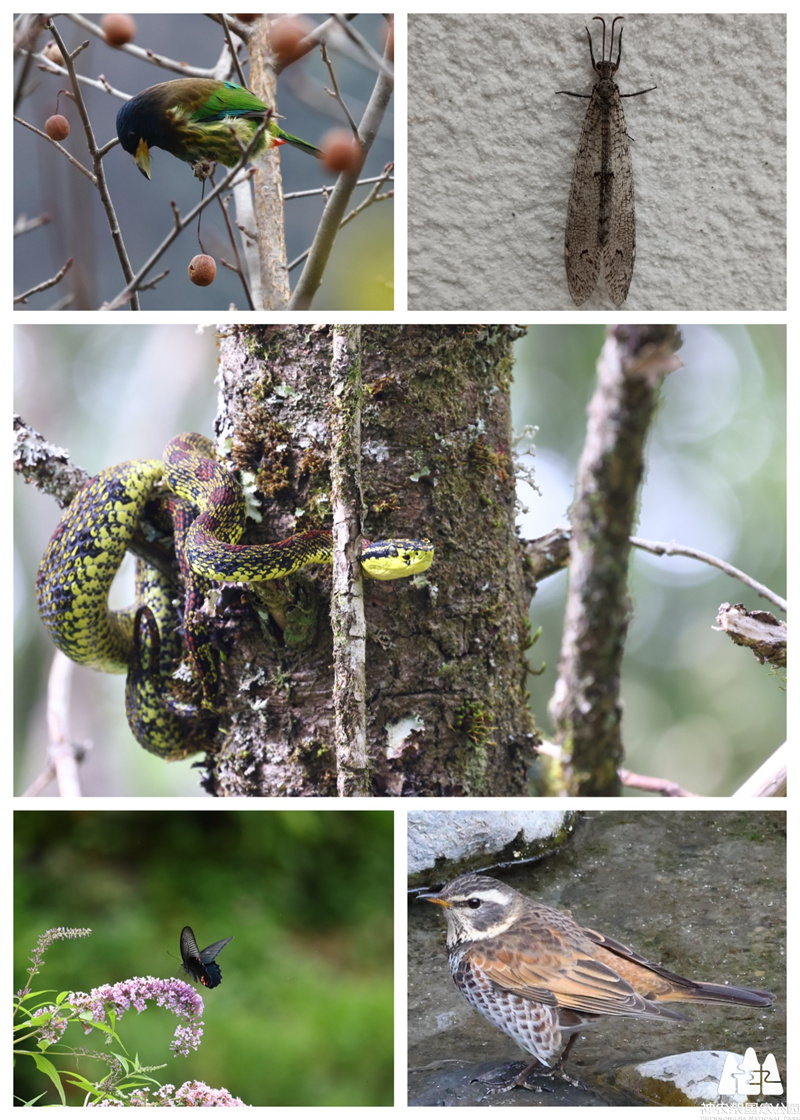Ma Guofei: Finding One's Research Direction Clears the Path Ahead
Updated:2024-11-13 Source:Shennongjia National Park
In early November 2024, our group arrived at Dajiuhu Wetland in Shennongjia to photograph the autumn scenery. The weather was perfect—blue skies, white clouds, with the Shennong Valley, Yinyu River, Tianji Ridge, and Wangyue Flat all enveloped in mist, creating a stunning and majestic view. Our journey took us from the valley to the mountain peak, weaving through autumn maples and red birch trees, then crossing fields of snow and ice-covered branches. As we descended back into the valley, we passed through high-altitude grasslands tinged with yellow and then glided over an expanse of primeval forest, finally reaching Pingqian, an ancient town in the northwest of Shennongjia.
 Photos taken by Ma Guofei
Photos taken by Ma GuofeiBy the time we arrived, it was lunch hour. Following the driver's lead, we made our way to Liu Yong's home, a place I had frequently visited in the past. I enjoy stopping by his house for a break or even staying overnight, not only because the food is authentic but also because public servants from the national park often stop here to rest, providing an opportunity to catch up on their recent work and achievements.
Sure enough, as soon as we got out of the car, I spotted Ma Guofei from the Scientific Research Institute of Shennongjia National Park through the glass window. I greeted him and walked over. As soon as I sat down, I eagerly asked him about any new discoveries during his current survey.
I was particularly curious because, like many other researchers in the park, Ma is diligent, curious, and often makes new discoveries. He's also a prolific writer, frequently sending us articles and photos.
"The waterfowl are mostly the same, but the population of wild ducks has increased to over two hundred. However, we did find a new species for Shennongjia— the Chinese Penduline-tit, which had never been recorded here before," Ma shared. Over the past few years, with the national park's increasing emphasis on biological monitoring, Ma has visited Dajiuhu Wetland every autumn to track migratory birds and gather valuable data for regional migration studies and bird conservation. This time, he had been staying for several days. Although he had a bit of a cold, he seemed in good spirits, with a camera equipped with a 600mm prime lens slung over his shoulder, looking quite comfortable.
"So, how's your state recently?" I asked. "Much better. Once I found my direction, I stopped feeling lost, and now I have the energy and enthusiasm for my work," he said.
The Scientific Research Institute of Shennongjia National Park is a highly specialized and regionally focused research institution. It's also the department in the national park with the largest talent pool and the most non-native personnel. Initially established for research on the golden snub-nosed monkey, the institute's role has expanded along with the development of the national park and the increasing importance of ecological conservation. Today, its responsibilities continue to grow, covering a broad range of tasks. The staff is increasingly stretched thin, facing the challenge of managing numerous responsibilities with a limited workforce.
"The institute is focused on studying the natural resources of Shennongjia. We need to have an intimate understanding of all the park's baseline resources, from geology and geomorphology to surface ecology, even the air, water, and noise levels. All of these must be monitored, analyzed, and studied continuously. Therefore, we need to develop local experts in different fields," Ma explained.
He added that he had been working in the national park for just over five years. Initially, he didn't focus on choosing his research direction, working tirelessly every day like a boar digging the earth. He was too caught up in the daily grind and didn't reflect on his work or its deeper meaning and true purpose.
 Ma Guofei and his colleague Mo Jiayong surveying the depth of Sphagnum L.
Ma Guofei and his colleague Mo Jiayong surveying the depth of Sphagnum L."To outsiders, Shennongjia might just seem like a forest, but this forest has extraordinary characteristics and an immeasurable value. It is a UNESCO Biosphere Reserve, a Global Geopark, and a natural World Heritage site, and it also has the Wetland of International Importance—Dajiuhu Wetland. It was even successfully listed on the IUCN Green List of Protected & Conserved Areas. The biodiversity here is incredibly rich, earning it the title of "gene bank for species" and "refuge for rare and endangered plants". This "Roof of Central China" has a profound impact on global ecological research, and every small change here matters."
Ma continued, "Now, the national government places great importance on building a protected area system with national parks as the mainstay, and the role of the research institute has become more prominent. The leadership of the institute encourages everyone to strengthen their professional knowledge and skills, but it's equally important for each individual to improve their own professional expertise in order to stand firm."
The construction of the national park is a long and challenging journey. Only with the active contributions and relentless efforts of researchers like Ma Guofei will China's national parks become a global model for ecological conservation! (Written by He Sai Jessie Ning) Copyright Shennongjia National Park
Address:36 Chulin Road, Muyu Town, Shennongjia Forestry District, Hubei Province 鄂ICP备18005077号-3
Address:36 Chulin Road, Muyu Town, Shennongjia Forestry District, Hubei Province 鄂ICP备18005077号-3
Email:2673990569@qq.com
Phone:0719-3453368
Phone:0719-3453368


TOP

